英语修辞手法及例句
英语19种修辞手法的全部解释和例句
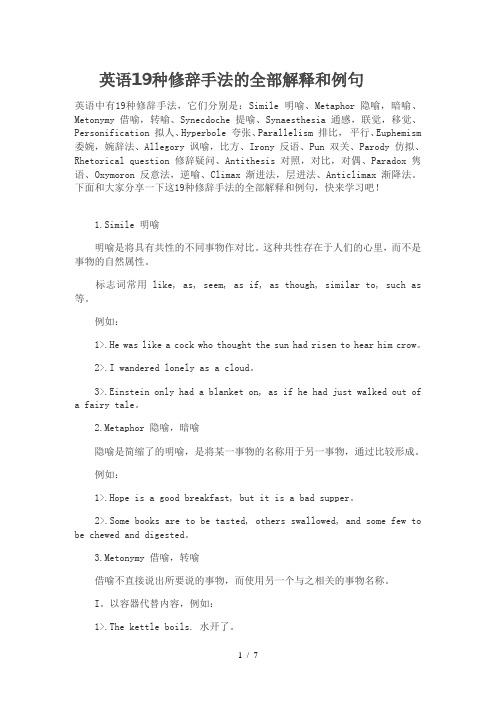
英语19种修辞手法的全部解释和例句英语中有19种修辞手法,它们分别是:Simile明喻、Metaphor 隐喻,暗喻、Metonymy 借喻,转喻、Synecdoche 提喻、Synaesthesia 通感,联觉,移觉、Personification 拟人、Hyperbole 夸张、Parallelism 排比,平行、Euphemism 委婉,婉辞法、Allegory 讽喻,比方、Irony 反语、Pun 双关、Parody 仿拟、Rhetorical question 修辞疑问、Antithesis 对照,对比,对偶、Paradox 隽语、Oxymoron 反意法,逆喻、Climax 渐进法,层进法、Anticlimax 渐降法。
下面和大家分享一下这19种修辞手法的全部解释和例句,快来学习吧!1.Simile 明喻明喻是将具有共性的不同事物作对比。
这种共性存在于人们的心里,而不是事物的自然属性。
标志词常用 like, as, seem, as if, as though, similar to, such as 等。
例如:1>.He was like a cock who thought the sun had risen to hear him crow。
2>.I wandered lonely as a cloud。
3>.Einstein only had a blanket on, as if he had just walked out ofa fairy tale。
2.Metaphor 隐喻,暗喻隐喻是简缩了的明喻,是将某一事物的名称用于另一事物,通过比较形成。
例如:1>.Hope is a good breakfast, but it is a bad supper。
2>.Some books are to be tasted, others swallowed, and some few to be chewed and digested。
英语修辞手法及例句
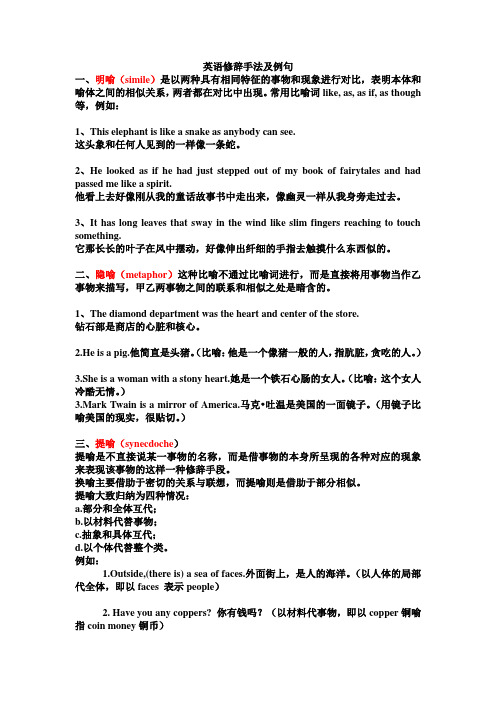
英语修辞手法及例句一、明喻(simile)是以两种具有相同特征的事物和现象进行对比,表明本体和喻体之间的相似关系,两者都在对比中出现。
常用比喻词like, as, as if, as though 等,例如:1、This elephant is like a snake as anybody can see.这头象和任何人见到的一样像一条蛇。
2、He looked as if he had just stepped out of my book of fairytales and had passed me like a spirit.他看上去好像刚从我的童话故事书中走出来,像幽灵一样从我身旁走过去。
3、It has long leaves that sway in the wind like slim fingers reaching to touch something.它那长长的叶子在风中摆动,好像伸出纤细的手指去触摸什么东西似的。
二、隐喻(metaphor)这种比喻不通过比喻词进行,而是直接将用事物当作乙事物来描写,甲乙两事物之间的联系和相似之处是暗含的。
1、The diamond department was the heart and center of the store.钻石部是商店的心脏和核心。
2.He is a pig.他简直是头猪。
(比喻:他是一个像猪一般的人,指肮脏,贪吃的人。
)3.She is a woman with a stony heart.她是一个铁石心肠的女人。
(比喻:这个女人冷酷无情。
)3.Mark Twain is a mirror of America.马克•吐温是美国的一面镜子。
(用镜子比喻美国的现实,很贴切。
)三、提喻(synecdoche)提喻是不直接说某一事物的名称,而是借事物的本身所呈现的各种对应的现象来表现该事物的这样一种修辞手段。
换喻主要借助于密切的关系与联想,而提喻则是借助于部分相似。
英语修辞手法的解释和例句

英语修辞手法的解释和例句1.Simile 明喻明喻是将具有共性的不同事物作对比。
这种共性存在于人们的心里,而不是事物的自然属性。
标志词常用like, as, seem, as if,as though, similar to, such as等.例如:1>.He was like a cock who thought the sun had risen to hear him crow。
2>。
I wandered lonely as a cloud。
3〉。
Einstein only had a blanket on,as if he had just walked out of a fairy tale.2.Metaphor 隐喻,暗喻隐喻是简缩了的明喻,是将某一事物的名称用于另一事物,通过比较形成。
例如:1>。
Hope is a good breakfast, but it is a bad supper。
2>.Some books are to be tasted,others swallowed,and some few to be chewed and digested。
3。
Metonymy 借喻,转喻借喻不直接说出所要说的事物,而使用另一个与之相关的事物名称。
I。
以容器代替内容,例如:1>.The kettle boils。
水开了.2〉.The room sat silent。
全屋人安静地坐着.II.以资料.工具代替事物的名称,例如:Lend me your ears, please. 请听我说.III.以作者代替作品,例如:a complete Shakespeare 莎士比亚全集VI。
以具体事物代替抽象概念,例如:I had the muscle, and they made money out of it. 我有力气,他们就用我的力气赚钱。
4.Synecdoche 提喻提喻用部分代替全体,或用全体代替部分,或特殊代替一般。
英语中19种修辞手法的全部解释和例句解析

8.Parallelism 排比, 平行
这种修辞法是把两个或两个以上的结构大 体相同或相似,意思相关,语气一致的短语. 句子排列成串,形成一个整体. 1>.No one can be perfectly free till all are free; no one can be perfectly moral till all are moral; no one can be perfectly happy till all are happy. 所有的人自由後,才能完全自由;所有的 人都有道德,才能完全合乎道德;所有的 人都幸福了,才能真正幸福。
2.Metaphor 隐喻,暗喻
隐喻是简缩了的明喻,是将某一事物 的名称用于另一事物,通过比较形成. 例如: 1>.Hope is a good breakfast, but it is a bad supper. 2>.Some books are to be tasted, others swallowed, and some few to be chewed and digested.
这种修辞是将一系列词语按照意念的大 小.轻重.深浅.高低等逐层渐进,最后达到 顶点.可以增强语势,逐渐加深读者印象. 例如: 1>.I am sorry, I am so sorry, I am so extremely sorry.
19.Anticlimax 渐降法
The duties of a soldier are to protect his country and peel potatoes.
11.Iro误时,用赞同过 失的说法,而在表扬时,则近乎责难的说 法. 1>.It would be a fine thing indeed not knowing what time it was in the morning. 早上没有时间观念还真是一件 好事啊(真实含义是应该明确早上的时 间观念)
英语修辞手法有哪些 英语修辞手法大全 修辞手法解释和例句
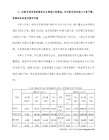
3>.Einstein only had a blanket on, as if he had just walked out of a fairy tale.
2.Metaphor 隐喻,暗喻
隐喻是简缩了的明喻,是将某一事物的名称用于另一事物,通过比较形成.
2>.The child is the father to the man.(童年时代可决定人之未来)三岁看大,四岁看老。
17.Oxymoron 反意法,逆喻
这也是一种矛盾修辞法,用两种不相调和的特征形容一个事物,以不协调的搭配使读者领悟句中微妙的含义.
例如:
1>.No light, but rather darkness visible.没有光亮,黑暗却清晰可见
借喻不直接说出所要说的事物,而使用另一个与之相关的事物名称.
I.以容器代替内容,例如:
1>.The kettle boils. 水开了.
2>.The room sat silent. 全屋人安静地坐着.
II.以资料.工具代替事物的名称,例如:
Lend me your ears, please. 请听我说.
这种修辞法是把两个或两个以上的结构大体相同或相似,意思相关,语气一致的短语.句子排列成串,形成一个整体.
例如:
1>.No one can be perfectly free till all are free; no one can be perfectly moral till all are moral; no one can be perfectly happy till all are happy.
15种修辞方法及例句英文
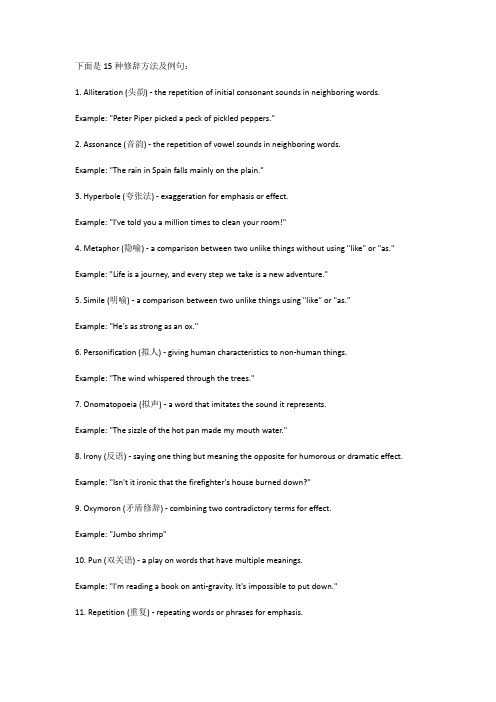
下面是15种修辞方法及例句:1. Alliteration (头韵) - the repetition of initial consonant sounds in neighboring words. Example: "Peter Piper picked a peck of pickled peppers."2. Assonance (音韵) - the repetition of vowel sounds in neighboring words.Example: "The rain in Spain falls mainly on the plain."3. Hyperbole (夸张法) - exaggeration for emphasis or effect.Example: "I've told you a million times to clean your room!"4. Metaphor (隐喻) - a comparison between two unlike things without using "like" or "as." Example: "Life is a journey, and every step we take is a new adventure."5. Simile (明喻) - a comparison between two unlike things using "like" or "as." Example: "He's as strong as an ox."6. Personification (拟人) - giving human characteristics to non-human things.Example: "The wind whispered through the trees."7. Onomatopoeia (拟声) - a word that imitates the sound it represents.Example: "The sizzle of the hot pan made my mouth water."8. Irony (反语) - saying one thing but meaning the opposite for humorous or dramatic effect. Example: "Isn't it ironic that the firefighter's house burned down?"9. Oxymoron (矛盾修辞) - combining two contradictory terms for effect.Example: "Jumbo shrimp"10. Pun (双关语) - a play on words that have multiple meanings.Example: "I'm reading a book on anti-gravity. It's impossible to put down."11. Repetition (重复) - repeating words or phrases for emphasis.Example: "I have a dream..."12. Rhetorical Question (反问) - a question asked for effect, not meant to be answered. Example: "Can't we all just get along?"13. Parallelism (排比) - using similar grammatical structures to emphasize a point. Example: "We came, we saw, we conquered."14. Allusion (典故) - referring to something well-known in history, literature, or culture. Example: "She has the wisdom of Solomon."15. Antithesis (对偶) - contrasting two ideas or phrases for effect.Example: "It was the best of times, it was the worst of times."。
英文中最常见的20种修辞手法(解释例句)
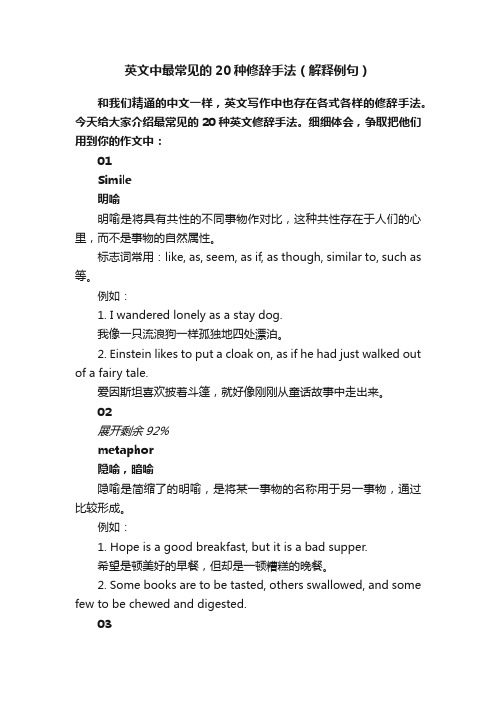
英文中最常见的20种修辞手法(解释例句)和我们精通的中文一样,英文写作中也存在各式各样的修辞手法。
今天给大家介绍最常见的20种英文修辞手法。
细细体会,争取把他们用到你的作文中:01Simile明喻明喻是将具有共性的不同事物作对比,这种共性存在于人们的心里,而不是事物的自然属性。
标志词常用:like, as, seem, as if, as though, similar to, such as 等。
例如:1. I wandered lonely as a stay dog.我像一只流浪狗一样孤独地四处漂泊。
2. Einstein likes to put a cloak on, as if he had just walked out of a fairy tale.爱因斯坦喜欢披着斗篷,就好像刚刚从童话故事中走出来。
02展开剩余92%metaphor隐喻,暗喻隐喻是简缩了的明喻,是将某一事物的名称用于另一事物,通过比较形成。
例如:1. Hope is a good breakfast, but it is a bad supper.希望是顿美好的早餐,但却是一顿糟糕的晚餐。
2. Some books are to be tasted, others swallowed, and some few to be chewed and digested.03metonymy借喻,转喻借喻不直接说出所要说的事物,而使用另一个与之相关的事物名称.1. 以容器代替内容,例如:1)The kettle boils.水开了。
2)The room sat silent.全屋人安静地坐着。
2. 以资料、工具代替事物的名称,例如:Lend me your ears, please.请听我说。
3. 以作者代替作品,例如:a complete Shakespeare莎士比亚全集4. 以具体事物代替抽象概念,例如:I had the muscle, and they made money out of it.我有力气,他们就用我的力气赚钱。
英语修辞手法的解释和例句
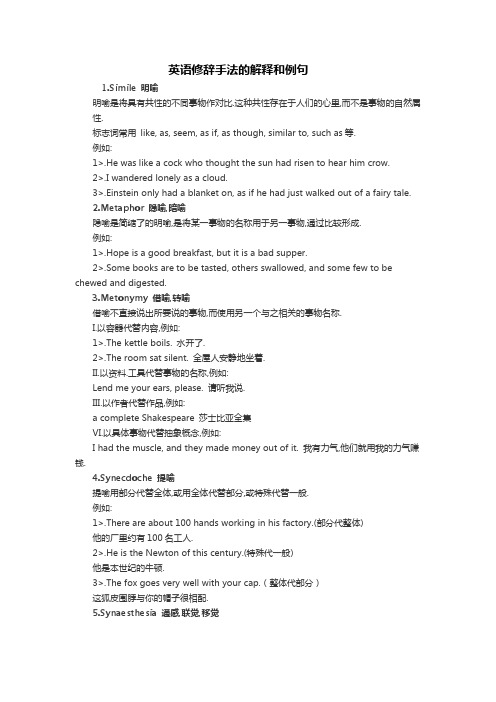
英语修辞手法的解释和例句1.Simile 明喻明喻是将具有共性的不同事物作对比.这种共性存在于人们的心里,而不是事物的自然属性.标志词常用like, as, seem, as if, as though, similar to, such as等.例如:1>.He was like a cock who thought the sun had risen to hear him crow.2>.I wandered lonely as a cloud.3>.Einstein only had a blanket on, as if he had just walked out of a fairy tale.2.Metaphor 隐喻,暗喻隐喻是简缩了的明喻,是将某一事物的名称用于另一事物,通过比较形成.例如:1>.Hope is a good breakfast, but it is a bad supper.2>.Some books are to be tasted, others swallowed, and some few to be chewed and digested.3.Metonymy 借喻,转喻借喻不直接说出所要说的事物,而使用另一个与之相关的事物名称.I.以容器代替内容,例如:1>.The kettle boils. 水开了.2>.The room sat silent. 全屋人安静地坐着.II.以资料.工具代替事物的名称,例如:Lend me your ears, please. 请听我说.III.以作者代替作品,例如:a complete Shakespeare 莎士比亚全集VI.以具体事物代替抽象概念,例如:I had the muscle, and they made money out of it. 我有力气,他们就用我的力气赚钱.4.Synecdoche 提喻提喻用部分代替全体,或用全体代替部分,或特殊代替一般.例如:1>.There are about 100 hands working in his factory.(部分代整体)他的厂里约有100名工人.2>.He is the Newton of this century.(特殊代一般)他是本世纪的牛顿.3>.The fox goes very well with your cap.(整体代部分)这狐皮围脖与你的帽子很相配.5.Synaesthesia 通感,联觉,移觉这种修辞法是以视.听.触.嗅.味等感觉直接描写事物.通感就是把不同感官的感觉沟通起来,借联想引起感觉转移,“以感觉写感觉”。
英语31修辞手法及例句
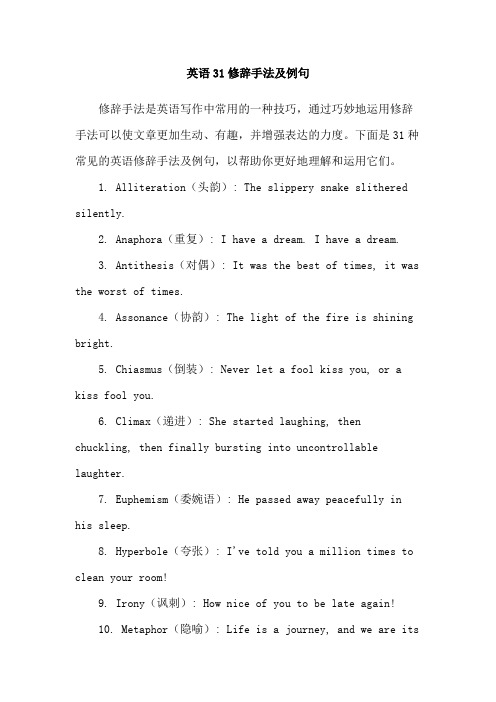
英语31修辞手法及例句修辞手法是英语写作中常用的一种技巧,通过巧妙地运用修辞手法可以使文章更加生动、有趣,并增强表达的力度。
下面是31种常见的英语修辞手法及例句,以帮助你更好地理解和运用它们。
1. Alliteration(头韵): The slippery snake slithered silently.2. Anaphora(重复): I have a dream. I have a dream.3. Antithesis(对偶): It was the best of times, it was the worst of times.4. Assonance(协韵): The light of the fire is shining bright.5. Chiasmus(倒装): Never let a fool kiss you, or a kiss fool you.6. Climax(递进): She started laughing, then chuckling, then finally bursting into uncontrollable laughter.7. Euphemism(委婉语): He passed away peacefully in his sleep.8. Hyperbole(夸张): I've told you a million times to clean your room!9. Irony(讽刺): How nice of you to be late again!10. Metaphor(隐喻): Life is a journey, and we are itspassengers.11. Onomatopoeia(拟声): The bees buzzed by my ear.12. Oxymoron(矛盾修饰): The silence was deafening.13. Parallelism(并列结构): She likes cooking, swimming, and reading.14. Personification(拟人): The flowers danced in the wind.15. Pun(双关): I used to be a baker, but I couldn't make enough dough.16. Repetition(重复): I must do it. I will do it. I can do it.17. Rhetorical question(修辞疑问): Who can resist the aroma of freshly baked bread?18. Simile(明喻): Her smile is as bright as the sun.19. Synecdoche(提喻法): The pen is mightier than the sword.20. Allusion(典故): She had a Mona Lisa smile on her face.21. Apostrophe(呼唤): Oh, love, why do you torment me so?22. Consonance(协音): The ship has sailed to the farthest shores.23. Enjambment(跨行): I wandered lonely as a cloudThat floats on high o'er vales and hills.24. Litotes(婉言): She is not unkind.25. Metonymy(转喻): The pen is mightier than the sword.26. Paradox(悖论): The more you know, the more you don't know.27. Periphrasis(迂回说法): The city that never sleeps (New York City).28. Sarcasm(讽刺): Oh, you're so clever, I can hardly stand it.29. Symbolism(象征): The dove represents peace.30. Understatement(轻描淡写): It's just a little cut, no need to make a fuss.31. Zeugma(两义): She lost her keys and her temper.这些修辞手法在英语写作中非常常见,它们可以使文章更加生动有趣,同时也能够增强表达的力度。
英语19种修辞手法的全部解释和例句
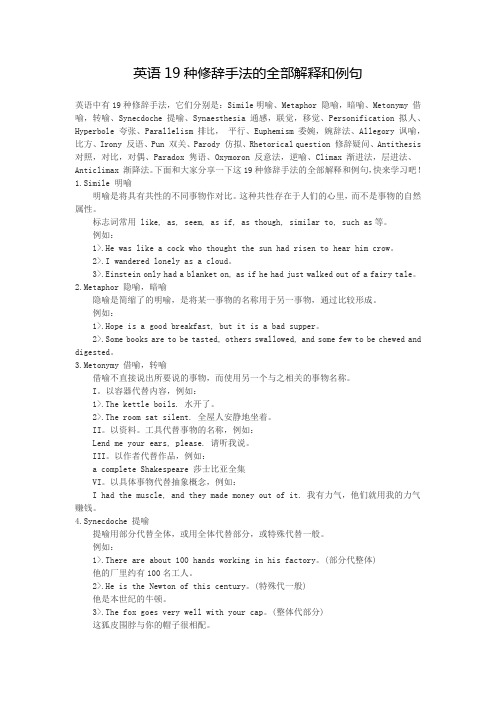
英语19种修辞手法的全部解释和例句英语中有19种修辞手法,它们分别是:Simile明喻、Metaphor 隐喻,暗喻、Metonymy 借喻,转喻、Synecdoche 提喻、Synaesthesia 通感,联觉,移觉、Personification 拟人、Hyperbole 夸张、Parallelism 排比,平行、Euphemism 委婉,婉辞法、Allegory 讽喻,比方、Irony 反语、Pun 双关、Parody 仿拟、Rhetorical question 修辞疑问、Antithesis 对照,对比,对偶、Paradox 隽语、Oxymoron 反意法,逆喻、Climax 渐进法,层进法、Anticlimax 渐降法。
下面和大家分享一下这19种修辞手法的全部解释和例句,快来学习吧!1.Simile 明喻明喻是将具有共性的不同事物作对比。
这种共性存在于人们的心里,而不是事物的自然属性。
标志词常用 like, as, seem, as if, as though, similar to, such as等。
例如:1>.He was like a cock who thought the sun had risen to hear him crow。
2>.I wandered lonely as a cloud。
3>.Einstein only had a blanket on, as if he had just walked out of a fairy tale。
2.Metaphor 隐喻,暗喻隐喻是简缩了的明喻,是将某一事物的名称用于另一事物,通过比较形成。
例如:1>.Hope is a good breakfast, but it is a bad supper。
2>.Some books are to be tasted, others swallowed, and some few to be chewed and digested。
英语13种修辞手法
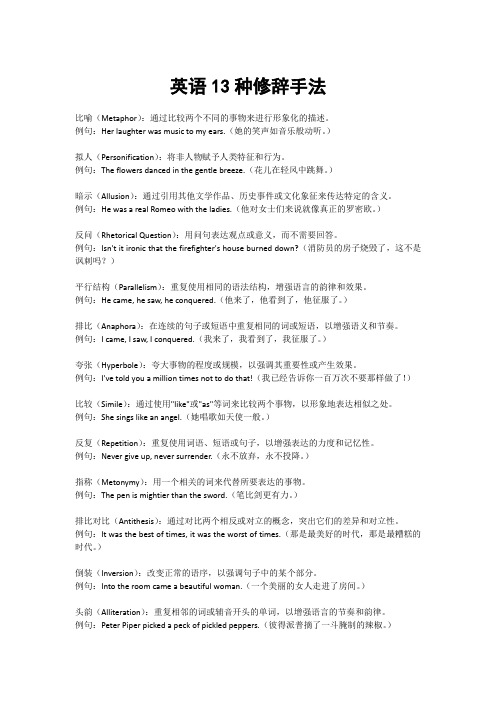
英语13种修辞手法比喻(Metaphor):通过比较两个不同的事物来进行形象化的描述。
例句:Her laughter was music to my ears.(她的笑声如音乐般动听。
)拟人(Personification):将非人物赋予人类特征和行为。
例句:The flowers danced in the gentle breeze.(花儿在轻风中跳舞。
)暗示(Allusion):通过引用其他文学作品、历史事件或文化象征来传达特定的含义。
例句:He was a real Romeo with the ladies.(他对女士们来说就像真正的罗密欧。
)反问(Rhetorical Question):用问句表达观点或意义,而不需要回答。
例句:Isn't it ironic that the firefighter's house burned down?(消防员的房子烧毁了,这不是讽刺吗?)平行结构(Parallelism):重复使用相同的语法结构,增强语言的韵律和效果。
例句:He came, he saw, he conquered.(他来了,他看到了,他征服了。
)排比(Anaphora):在连续的句子或短语中重复相同的词或短语,以增强语义和节奏。
例句:I came, I saw, I conquered.(我来了,我看到了,我征服了。
)夸张(Hyperbole):夸大事物的程度或规模,以强调其重要性或产生效果。
例句:I've told you a million times not to do that!(我已经告诉你一百万次不要那样做了!)比较(Simile):通过使用"like"或"as"等词来比较两个事物,以形象地表达相似之处。
例句:She sings like an angel.(她唱歌如天使一般。
)反复(Repetition):重复使用词语、短语或句子,以增强表达的力度和记忆性。
英语中所有19种修辞手法的全部解释和例句

英语中所有19种修辞手法的全部解释和例句1.Simile 明喻明喻是将具有共性的不同事物作对比.这种共性存在于人们的心里,而不是事物的自然属性.标志词常用 like, as, seem, as if, as though, similar to, such as等.例如:1>.He was like a cock who thought the sun had risen to hear him crow.2>.I wandered lonely as a cloud.3>.Einstein only had a blanket on, as if he had just walked out of a fairy tale.2.Metaphor 隐喻,暗喻隐喻是简缩了的明喻,是将某一事物的名称用于另一事物,通过比较形成.例如:1>.Hope is a good breakfast, but it is a bad supper.2>.Some books are to be tasted, others swallowed, and some few to be chewed and digested.3.Metonymy 借喻,转喻借喻不直接说出所要说的事物,而使用另一个与之相关的事物名称.I.以容器代替内容,例如:1>.The kettle boils. 水开了.2>.The room sat silent. 全屋人安静地坐着.II.以资料.工具代替事物的名称,例如:Lend me your ears, please. 请听我说.III.以作者代替作品,例如:a complete Shakespeare 莎士比亚全集VI.以具体事物代替抽象概念,例如:I had the muscle, and they made money out of it. 我有力气,他们就用我的力气赚钱.4.Synecdoche 提喻提喻用部分代替全体,或用全体代替部分,或特殊代替一般.例如:1>.There are about 100 hands working in his factory.(部分代整体)他的厂里约有100名工人.2>.He is the Newton of this century.(特殊代一般)他是本世纪的牛顿.3>.The fox goes very well with your cap.(整体代部分)这狐皮围脖与你的帽子很相配.5.Synaesthesia 通感,联觉,移觉这种修辞法是以视.听.触.嗅.味等感觉直接描写事物.通感就是把不同感官的感觉沟通起来,借联想引起感觉转移,“以感觉写感觉”。
英语中19种修辞手法和例句(推荐阅读)

英语中19种修辞手法和例句(推荐阅读)第一篇:英语中19种修辞手法和例句1.Simile 明喻明喻是将具有共性的不同事物作对比.这种共性存在于人们的心里,而不是事物的自然属性.标志词常用like, as, seem, as if, as though, similar to, such as等.例如:1>.He was like a cock who thought the sun had risen to hear him crow.2>.I wandered lonely as a cloud.3>.Einstein only had a blanket on, as if he had just walked out of a fairy tale.2.Metaphor 隐喻,暗喻隐喻是简缩了的明喻,是将某一事物的名称用于另一事物,通过比较形成.例如:1>.Hope is a good breakfast, but it is a bad supper.2>.Some books are to be tasted, others swallowed, and some few to be chewed and digested.3.Metonymy 借喻,转喻借喻不直接说出所要说的事物,而使用另一个与之相关的事物名称.I.以容器代替内容,例如:1>.The kettle boils.水开了.2>.The room sat silent.全屋人安静地坐着.II.以资料.工具代替事物的名称,例如:Lend me your ears, please.请听我说.III.以作者代替作品,例如:a complete Shakespeare 莎士比亚全集VI.以具体事物代替抽象概念,例如:I had the muscle, and they made money out of it.我有力气,他们就用我的力气赚钱.4.Synecdoche 提喻提喻用部分代替全体,或用全体代替部分,或特殊代替一般.例如:1>.There are about 100 hands working in his factory.(部分代整体)他的厂里约有100名工人.2>.He is the Newton of this century.(特殊代一般)他是本世纪的牛顿.3>.The fox goes very well with your cap.(整体代部分)这狐皮围脖与你的帽子很相配.5.Synaesthesia 通感,联觉,移觉这种修辞法是以视.听.触.嗅.味等感觉直接描写事物.通感就是把不同感官的感觉沟通起来,借联想引起感觉转移,“以感觉写感觉”。
英语19种修辞手法的全部解释和例句

英语19种修辞手法的全部解释和例句英语中有19种修辞手法,它们分别是:Simile明喻、Metaphor 隐喻,暗喻、Metonymy 借喻,转喻、Synecdoche 提喻、Synaesthesia 通感,联觉,移觉、Personification 拟人、Hyperbole 夸张、Parallelism 排比,平行、Euphemism 委婉,婉辞法、Allegory 讽喻,比方、Irony 反语、Pun 双关、Parody 仿拟、Rhetorical question 修辞疑问、Antithesis 对照,对比,对偶、Paradox 隽语、Oxymoron 反意法,逆喻、Climax 渐进法,层进法、Anticlimax 渐降法。
下面和大家分享一下这19种修辞手法的全部解释和例句,快来学习吧!1.Simile 明喻明喻是将具有共性的不同事物作对比。
这种共性存在于人们的心里,而不是事物的自然属性。
标志词常用 like, as, seem, as if, as though, similar to, such as 等。
例如:1>.He was like a cock who thought the sun had risen to hear him crow。
2>.I wandered lonely as a cloud。
3>.Einstein only had a blanket on, as if he had just walked out ofa fairy tale。
2.Metaphor 隐喻,暗喻隐喻是简缩了的明喻,是将某一事物的名称用于另一事物,通过比较形成。
例如:1>.Hope is a good breakfast, but it is a bad supper。
2>.Some books are to be tasted, others swallowed, and some few to be chewed and digested。
英语修辞手法及例句

英语修辞手法及例句一、明喻(simile)是以两种具有相同特征的事物和现象进行对比,表明本体和喻体之间的相似关系,两者都在对比中出现。
常用比喻词like, as, as if, as though等,例如:1、This elephant is like a snake as anybody can see.这头象和任何人见到的一样像一条蛇。
2、He looked as if he had just stepped out of my book of fairytales and had passed me like a spirit.他看上去好像刚从我的童话故事书中走出来,像幽灵一样从我身旁走过去。
3、It has long leaves that sway in the wind like slim fingers reaching to touch something.它那长长的叶子在风中摆动,好像伸出纤细的手指去触摸什么东西似的。
二、隐喻(metaphor)这种比喻不通过比喻词进行,而是直接将用事物当作乙事物来描写,甲乙两事物之间的联系和相似之处是暗含的。
1、The diamond department was the heart and center of the store.钻石部是商店的心脏和核心。
2. He is a pig.他简直是头猪。
(比喻:他是一个像猪一般的人,指肮脏,贪吃的人。
)3.She is a woman with a stony heart.她是一个铁石心肠的女人。
(比喻:这个女人冷酷无情。
)3. Mark Twain is a mirror of America. 马克?吐温是美国的一面镜子。
(用镜子比喻美国的现实,很贴切。
)三、提喻(synecdoche提喻是不直接说某一事物的名称,而是借事物的本身所呈现的各种对应的现象来表现该事物的这样一种修辞手段。
换喻主要借助于密切的关系与联想,而提喻则是借助于部分相似。
20种常见英文修辞手法
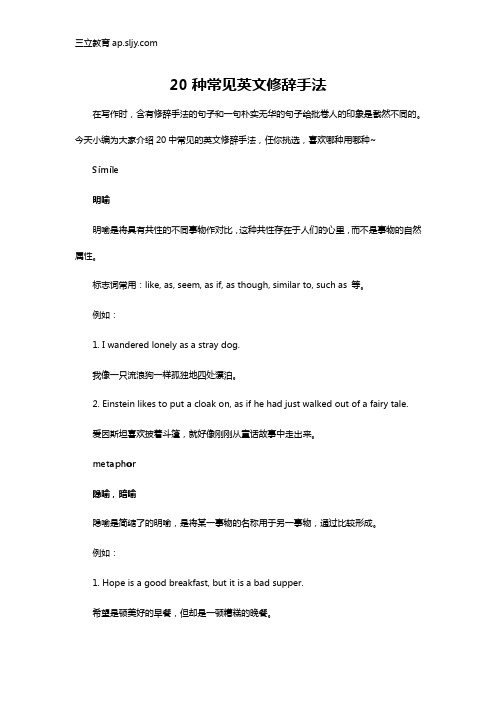
20种常见英文修辞手法在写作时,含有修辞手法的句子和一句朴实无华的句子给批卷人的印象是截然不同的。
今天小编为大家介绍20中常见的英文修辞手法,任你挑选,喜欢哪种用哪种~ Simile明喻明喻是将具有共性的不同事物作对比,这种共性存在于人们的心里,而不是事物的自然属性。
标志词常用:like, as, seem, as if, as though, similar to, such as 等。
例如:1. I wandered lonely as a stray dog.我像一只流浪狗一样孤独地四处漂泊。
2. Einstein likes to put a cloak on, as if he had just walked out of a fairy tale.爱因斯坦喜欢披着斗篷,就好像刚刚从童话故事中走出来。
metaphor隐喻,暗喻隐喻是简缩了的明喻,是将某一事物的名称用于另一事物,通过比较形成。
例如:1. Hope is a good breakfast, but it is a bad supper.希望是顿美好的早餐,但却是一顿糟糕的晚餐。
2. Some books are to be tasted, others swallowed, and some few to be chewed and digested.一些书需要被“浅尝辄止”地阅读,另一些需要被“狼吞虎咽”般地阅读;很少一部分需要被“细嚼慢咽”地阅读。
metonymy借喻,转喻借喻不直接说出所要说的事物,而使用另一个与之相关的事物名称。
1. 以容器代替内容,例如:1)The kettle boils.水开了。
2)The room sat silent.全屋人安静地坐着。
2. 以资料、工具代替事物的名称,例如:Lend me your ears, please.请听我说。
3. 以作者代替作品,例如:a complete Shakespeare莎士比亚全集4. 以具体事物代替抽象概念,例如:I had the muscle, and they made money out of it.我有力气,他们就用我的力气赚钱。
(完整word版)英语中所有19种修辞手法的全部解释和例句
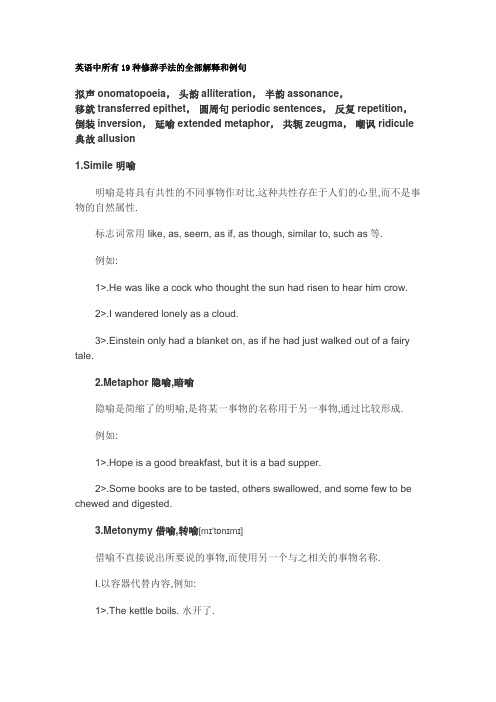
英语中所有19种修辞手法的全部解释和例句拟声onomatopoeia,头韵alliteration,半韵assonance,移就transferred epithet,圆周句periodic sentences,反复repetition,倒装inversion,延喻 extended metaphor,共轭zeugma,嘲讽 ridicule 典故allusion1.Simile 明喻明喻是将具有共性的不同事物作对比.这种共性存在于人们的心里,而不是事物的自然属性.标志词常用 like, as, seem, as if, as though, similar to, such as等.例如:1>.He was like a cock who thought the sun had risen to hear him crow.2>.I wandered lonely as a cloud.3>.Einstein only had a blanket on, as if he had just walked out of a fairy tale.2.Metaphor 隐喻,暗喻隐喻是简缩了的明喻,是将某一事物的名称用于另一事物,通过比较形成.例如:1>.Hope is a good breakfast, but it is a bad supper.2>.Some books are to be tasted, others swallowed, and some few to be chewed and digested.3.Metonymy 借喻,转喻[mɪ'tɒnɪmɪ]借喻不直接说出所要说的事物,而使用另一个与之相关的事物名称.I.以容器代替内容,例如:1>.The kettle boils. 水开了.2>.The room sat silent. 全屋人安静地坐着.II.以资料.工具代替事物的名称,例如:Lend me your ears, please. 请听我说.III.以作者代替作品,例如:a complete Shakespeare 莎士比亚全集VI.以具体事物代替抽象概念,例如:I had the muscle, and they made money out of it. 我有力气,他们就用我的力气赚钱.4.Synecdoche 提喻[sɪ'nekdəkɪ]提喻用部分代替全体,或用全体代替部分,或特殊代替一般.例如:1>.There are about 100 hands working in his factory.(部分代整体)他的厂里约有100名工人.2>.He is the Newton of this century.(特殊代一般)他是本世纪的牛顿.3>.The fox goes very well with your cap.(整体代部分)这狐皮围脖与你的帽子很相配.5.Synaesthesia 通感,联觉,移觉[,sɪnɪs'θiːzɪə]这种修辞法是以视.听.触.嗅.味等感觉直接描写事物.通感就是把不同感官的感觉沟通起来,借联想引起感觉转移,“以感觉写感觉”。
英语中所有19种修辞手法的全部解释和例句
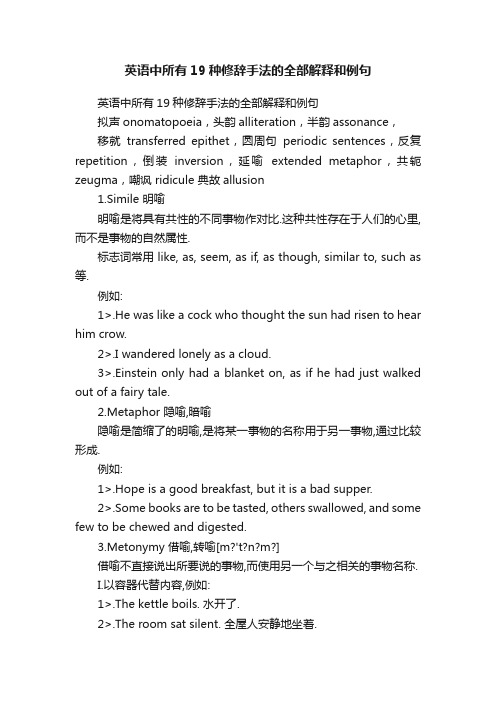
英语中所有19种修辞手法的全部解释和例句英语中所有19种修辞手法的全部解释和例句拟声onomatopoeia,头韵alliteration,半韵assonance,移就transferred epithet,圆周句periodic sentences,反复repetition,倒装inversion,延喻extended metaphor,共轭zeugma,嘲讽 ridicule 典故allusion1.Simile 明喻明喻是将具有共性的不同事物作对比.这种共性存在于人们的心里,而不是事物的自然属性.标志词常用 like, as, seem, as if, as though, similar to, such as 等.例如:1>.He was like a cock who thought the sun had risen to hear him crow.2>.I wandered lonely as a cloud.3>.Einstein only had a blanket on, as if he had just walked out of a fairy tale.2.Metaphor 隐喻,暗喻隐喻是简缩了的明喻,是将某一事物的名称用于另一事物,通过比较形成.例如:1>.Hope is a good breakfast, but it is a bad supper.2>.Some books are to be tasted, others swallowed, and some few to be chewed and digested.3.Metonymy 借喻,转喻[m?'t?n?m?]借喻不直接说出所要说的事物,而使用另一个与之相关的事物名称.I.以容器代替内容,例如:1>.The kettle boils. 水开了.2>.The room sat silent. 全屋人安静地坐着.II.以资料.工具代替事物的名称,例如:Lend me your ears, please. 请听我说.III.以作者代替作品,例如:a complete Shakespeare 莎士比亚全集VI.以具体事物代替抽象概念,例如:I had the muscle, and they made money out of it. 我有力气,他们就用我的力气赚钱.4.Synecdoche 提喻[s?'nekd?k?]提喻用部分代替全体,或用全体代替部分,或特殊代替一般.例如:1>.There are about 100 hands working in his factory.(部分代整体)他的厂里约有100名工人.2>.He is the Newton of this century.(特殊代一般)他是本世纪的牛顿.3>.The fox goes very well with your cap.(整体代部分)这狐皮围脖与你的帽子很相配.5.Synaesthesia 通感,联觉,移觉[,s?n?s'θi?z??]这种修辞法是以视.听.触.嗅.味等感觉直接描写事物.通感就是把不同感官的感觉沟通起来,借联想引起感觉转移,“以感觉写感觉”。
- 1、下载文档前请自行甄别文档内容的完整性,平台不提供额外的编辑、内容补充、找答案等附加服务。
- 2、"仅部分预览"的文档,不可在线预览部分如存在完整性等问题,可反馈申请退款(可完整预览的文档不适用该条件!)。
- 3、如文档侵犯您的权益,请联系客服反馈,我们会尽快为您处理(人工客服工作时间:9:00-18:30)。
英语修辞手法及例句一、明喻(simile)是以两种具有相同特征的事物和现象进行对比,表明本体和喻体之间的相似关系,两者都在对比中出现。
常用比喻词like, as, as if, as though 等,例如:1、This elephant is like a snake as anybody can see.这头象和任何人见到的一样像一条蛇。
2、He looked as if he had just stepped out of my book of fairytales and had passed me like a spirit.他看上去好像刚从我的童话故事书中走出来,像幽灵一样从我身旁走过去。
3、It has long leaves that sway in the wind like slim fingers reaching to touch something.它那长长的叶子在风中摆动,好像伸出纤细的手指去触摸什么东西似的。
二、隐喻(metaphor)这种比喻不通过比喻词进行,而是直接将用事物当作乙事物来描写,甲乙两事物之间的联系和相似之处是暗含的。
1、The diamond department was the heart and center of the store.钻石部是商店的心脏和核心。
is a pig.他简直是头猪。
(比喻:他是一个像猪一般的人,指肮脏,贪吃的人。
)is a woman with a stony heart.她是一个铁石心肠的女人。
(比喻:这个女人冷酷无情。
)Twain is a mirror of America.马克?吐温是美国的一面镜子。
(用镜子比喻美国的现实,很贴切。
)三、提喻(synecdoche)提喻是不直接说某一事物的名称,而是借事物的本身所呈现的各种对应的现象来表现该事物的这样一种修辞手段。
换喻主要借助于密切的关系与联想,而提喻则是借助于部分相似。
提喻大致归纳为四种情况:a.部分和全体互代;b.以材料代替事物;c.抽象和具体互代;d.以个体代替整个类。
例如:,(there is) a sea of faces.外面街上,是人的海洋。
(以人体的局部代全体,即以faces 表示people)2. Have you any coppers? 你有钱吗?(以材料代事物,即以copper铜喻指coin money铜币)share the same roof.他们住在一起。
(以部分代全体,即用roof屋顶,表示house屋子、住宅)is the Newton of this century.他是本世纪的牛顿。
(以个体代整个类,用Newton表示scientist科学家)was reported that China won the volleyball match.椐报载:在这次排球赛中,中国队赢了。
(以国家名称China代该国球队the Chinese Volleyball Team)was a wearing to him.生活令他感到厌倦。
(以抽象代具体,即用wearing喻指a wearing thing令人厌倦的事情)7、“...saying that it was the most beautiful tongue in the world,...”……他说这是世界上最美的语言。
这里用具体的“tongue”代替抽象的“language”。
四、拟人(personification)这种修辞方法是把人类的特点、特性加于外界事物之上,使之人格化,以物拟人,以达到彼此交融,合二为一。
My only worry was that January would find me hunting for a job again.我唯一担心的是,到了一月份我又得去找工作。
英语里常把“年”“月”“日”人格化,赋以生命,使人们读起来亲切生动。
五、夸张(hyperbole)这是运用丰富的想象,过激的言词,渲染和装饰客观事物,以达到强调的效果。
1、My blood froze.我的血液都凝固了。
2、When I told our father about this, his heart burst.当我将这件事告诉我们的父亲时,他的心几乎要迸出来。
3、My heart almost stopped beating when I heard my daughter’s voice on the phone.从电话里一听到我女儿的声音,我的心几乎停止跳动。
六、叠言(rhetorical repetition)这种修辞法是指在特定的语境中,将相同的结构,相同意义词组成句子重叠使用,以增强语气和力量。
1、It must be created by the blood and the work of all of us who believe in the future, who believe in man and his glorious man—made destiny.它必须用我们这些对于未来,对于人类以及人类自己创造的伟大命运具有信心的人的鲜血和汗水去创造。
2、... Because good technique in medicine and surgery means more quickly—cured patients, less pain, less discomfort, less death, less disease and less deformity.因为优良的医疗技术和外科手术意味着更快地治疗病人,更少痛苦,更少不安,更少死亡,更少疾病,和更少残废。
七、转喻(Metonymy)是指当甲事物同乙事物不相类似,但有密切关系时,可以利用这种关系,以乙事物的名称来取代甲事物,这样的一种修辞手段。
转喻的重点不是在“相似”;而是在“联想”。
转喻又称,或。
例如:kettle boils.壶水开。
(用the kettle壶,表示the water in the kettle 壶水)is fond of the bottle.他喜欢喝酒。
(用bottle装酒的瓶子,表示wine酒)hairs should be respected.老人应受到尊重。
(用grey hairs白发,表示old people老人)pen is mightier than the sword.笔要比剑更锋利。
(用pen笔,表示article 文章)am reading Lu xun.我在读鲁迅的作品。
(用Lu xun鲁迅,表示Lu Hsun's works鲁迅的作品)八、双关语(pun)是以一个词或词组,用巧妙的办法同时把互不关联的两种含义结合起来,以取得一种诙谐有趣的效果。
它主要以相似的词形.词意和谐音的方式出现.Napoleon was astonished.”Either you are mad, or I am,”he declared. “Both,sir!”cried the Swede proudly.“Both”一词一语双关,既指拿破仑和这位士兵都是疯子,又指这位战士参加过拿破仑指挥的两次战役。
九、拟声(onomatopoeia)是摹仿自然界中非语言的声音,其发音和所描写的事物的声音很相似,使语言显得生动,富有表现力。
1、On the root of the school house some pigeons were softly cooing.在学校房屋的屋顶上一些鸽子正轻轻地咕咕叫着。
2、She brought me into touch with everything that could be reached or felt——sunlight, the rustling of silk, the noises of insects, the creaking of a door, the voice of a loved one.她使我接触到所有够得着的或者感觉得到的东西,如阳光呀,丝绸摆动时的沙沙声呀,昆虫的叫声呀,开门的吱嗄声呀,亲人的说话声呀。
十、讽刺(irony)是指用含蓄的褒义词语来表示其反面的意义,从而达到使本义更加幽默,更加讽刺的效果。
Sarcasm,satireIt would be a fine thing indeed not knowing what time it was in the morning.早上没有时间观念还真是一件好事啊(真实含义是应该明确早上的时间观念)Well, of course, I knew that gentlemen like you carry only large notes.啊,当然,我知道像你这样的先生只带大票子。
店员这句话意在讽刺这位穿破衣的顾客:像你这样的人怎么会有大票子呢?名为“gentlemen”实则“beggar”而已。
十一、通感(synesthesia)[?sin?s'θi:?i?]是指在某个感官所产生的感觉,转到另一个感官的心理感受。
Taste the music of Mozart.(用嗅觉形容听觉)品尝Mozart的音乐.Some books are to be tasted, others to be swallowed and some few to be chewed and digested.有些书是应当尝尝滋味的,有些书是应当吞下去的,有少数书是应当咀嚼和消化的。
书是“尝”不出味道的,也是不能“吃”下去将其“消化”掉的。
这里把读书中的精读和泛读,阅读欣赏与吸收知识的感受,用味觉功能和消化功能来表示,心理感受是如此逼真和奇特。
十二、头韵法(alliteration)在文句中有两个以上连结在一起的词或词组,其开头的音节有同样的字母或声音,以增强语言的节奏感。
How and why he had come to Princeton, New Jersey is a story of struggle, success, and sadness.委婉,婉辞法婉辞法指用委婉,文雅的方法表达粗恶,避讳的话.例如:1>.He is out visiting the necessary? 他出去方便一下.2>.His relation with his wife has not been fortunate. 他与妻子关系不融洽.3>.Deng Xiaoping passed away in 1997. (去世)仿拟这是一种模仿名言.警句.谚语,改动其中部分词语,从而使其产生新意的修辞.例如:1>.Rome was not built in a day, nor in a year.2>.A friend in need is a friend to be avoided.question 修辞疑问(反问)它与疑问句的不同在于它并不以得到答复为目的,而是以疑问为手段,取得修辞上的效果,其特点是:肯定问句表示强烈否定,而否定问句表示强烈的肯定.它的答案往往是不言而喻的.例如:1>.How was it possible to walk for an hour through the woods and see nothing worth of note?2>.Shall we allow those untruths to go unanswered?隽语这是一种貌似矛盾,但包含一定哲理的意味深长的说法,是一种矛盾修辞法..例如:1>.More haste, less speed.欲速则不达2>.The child is the father to the man.(童年时代可决定人之未来)三岁看大,四岁看老。
